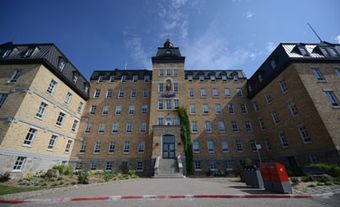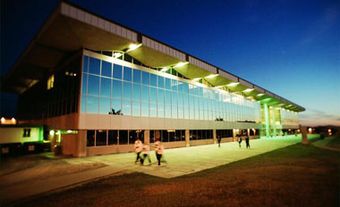The University of Ottawa was founded in Bytown, Canada West, as the College of Bytown in 1848. Bishop Joseph Bruno Guigues, the first bishop of what would become Ottawa, Ontario, was the college’s patron. It was originally sited beside the Bishop’s seat, which remains the Notre Dame Cathedral on Sussex Drive. As the college grew, it moved to the university’s current location in Sandy Hill and off of Main Street. The Main Street campus, which is 2.5 km south of the main campus, now houses the University of Saint Paul.

Origins
The College of Bytown was distinguished from the time of its founding in 1848 by Bishop Joseph Bruno Guigues’s focus on bilingualism. His hope was that bilingual education would bridge the divide between Protestants and Catholics as well as anglophone and francophone populations. (See also Francophone-Anglophone Relations.)
The college was officially incorporated by the Provincial Parliament the following year in 1849. From the start, the institution served the Ottawa Valley educational needs, but also served the Diocesan and Catholic need to educate the Canadian clergy.

(courtesy of the University of Ottawa's archives/AUO-NEG-NB-38AH-1-6)
The early years were fraught by financial difficulties that made the college’s existence tenuous. Bishop Guigues sought government funds and land use authorization. Neither were forthcoming, despite Guigues’s appeal to London in 1848. Eventually, in 1857, the college received £300 from the government — a sum roughly equivalent to $35,000 today. In contrast, Regiopolis College in Kingston, another Catholic school that emphasized studies in English, won £500 from government in 1847 and received funds each year thereafter. In 1868, Regiopolis received $4,500 from the new Province of Ontario.
These financial pressures caused the Diocese of Ottawa to fall into debt to the Missionary Oblates of Mary Immaculate. The Bishop sold the college in 1856 to the Oblates to settle the debt.
Once the Oblates took control, the college was infused with the French order’s foreign resources. In 1857, the college was host to eight professors and ninety students. Three years later, the college taught 160 students.
Legislative developments kept pace with these changes. The College of Bytown was renamed the College of Ottawa in 1861. In 1866, the college, then led by Father Timothy Ryan, successfully petitioned the legislature for university powers. Around six years later, Thomas Foran — who later became one of the best lawyers in the country during his time — received the university’s first baccalaureate degree. In 1875, he also received the college’s first master’s degree.
Bilingualism and Linguistic Tensions
Father Joseph-Henri Tabaret, whose time in Canada was devoted to the college’s growth, paved the way for its survival into the twentieth century. He carried on Bishop Guigues’s bilingual mission until 1874, when a growing number of anglophone students made bilingual education nearly impossible. French literature and religion courses continued to be taught in French, but the college taught all other courses in English.
Father Tabaret further exhorted the college toward expansion such that, by 1886, the college taught over 300 students. An English Debating Society, the first of its kind in Canada, was established in 1880. Its francophone equivalent, the Société des débats français, took root in 1887. The institution further invested in sports teams, with a football team established in 1881 and an Athletic Club in 1885. These teams sported garnet and grey, which remain the university’s colours. The university’s sports teams’ name, the GeeGees, is in fact a reference to the double “G” (garnet and grey) of the school’s colours.
The college’s growth during the end of the 19th century further earned it an ecclesiastic charter in 1889. This document, issued by the Pope, recognized the college’s degrees across the Catholic Church. Meanwhile, legislation passed in 1891 allowed the college to affiliate with other colleges and universities in Canada, although this power was not used for some twenty years.
Bilingualism was slowly restored to the university in 1898, when Oblate students at the juniorate put pressure on Rector Father Henri Constantineau to bring French back into the curriculum. This attempt did not succeed, but the attempt raised Franco-Irish tensions among Ottawans (See Ottawa). Indeed, during the early 20th century, the College of Ottawa was wracked by Franco-Irish conflict and by the Ontario Schools Question. The matter was finally resolved when, in 1915, all of the college’s Irish Oblate professors resigned, thus removing the loudest advocates for purely English studies. (See also Francophone-Anglophone Relations.)

(courtesy of the University of Ottawa's archives/AUO-PHO-NB-38A-1-78)
In the midst of these difficulties, the college lost its main building to fire on 2 December 1903. The fire claimed three lives and destroyed most of the college’s historic records. The building that replaced this wreck, Tabaret Hall, was constructed in 1904.
Expansion and Programs
The First World War affected the college very little; the interwar years were very significant for the college. Growth during this period was marked by the college’s influence as the only Catholic university in Canada outside of Quebec that offered courses in French. This encouraged twenty-four convents and colleges in Ontario and the Western provinces to affiliate themselves with the college. Many of these affiliates were francophone schools who sought to benefit from the university’s linguistic expertise.
The college expanded its educational offering by creating a normal school to train teachers as of 1923. A school of nursing was established in 1933. Both these schools served francophones in Ottawa and attracted a new demographic: female students, who would continue to attend the college in other degree programs. A Faculty of Canon Law was established in 1926, and the Faculty of Arts offered the first translation course in Canada in 1936.
The college was reorganized by provincial legislation in 1933 to account for the university’s new size. Its name was officially changed to the University of Ottawa; faculties were also formally recognized in this legislation.
The Second World War and the post-war economic boom spurred the university’s development. The School of Medicine was founded in 1945. A School of Applied Sciences followed. Graduate degrees, following the German model of graduate education, become more popular: a School for Graduate Studies was created in 1949. The Faculty of Law came later, in 1953, with a civil law section that grew from the university’s faculty of canon law. The common law section followed in 1957.
The university received expropriation powers in 1959 to expand its Sandy Hill campus, where most of its faculties were situated. The burden of a growing student population and campus caused the university’s expenses to reach a tipping point in the 1960s when the university ran a deficit every year. Negotiations with the provincial government bore little fruit: Ontario demanded that the Oblates relinquish control of the university.
The Oblates consented in 1965. The University of Ottawa Act, 1965 created a new university, named the University of Ottawa, while the old College of Ottawa continued as the University of Saint Paul. The two universities remain federated.
The Oblates fought a rearguard action to preserve religious influence at the University of Ottawa, to no avail. Roger Guindon, an Oblate appointed rector of the old university in 1964, remained rector at the new university until 1984. The university modernized during his tenure. Lay faculty and support staff were hired in great numbers, and women were hired in increasing numbers beginning in the 1970s. By 1990, the number of professors had increased from 300 in 1965 to 1,000.
Financial aid from the provincial government furthered the campus’s expansion through to 2000.
The University of Ottawa’s enduring influence is as a pillar for bilingual education in the Ottawa Valley and Ontario. The university’s bilingual approach, inherited from the Oblates, endures even today despite constrained provincial budgets and increasing competition. In 2020, the University of Ottawa had over 37,449 undergraduate and 7,244 graduate students. The university counted 1,223 regular professors among its academic staff.
Influence
Over the years, many notable figures have attended and served the university. Supreme Court Chief Justice Gérald Fauteux founded the university’s law faculty and went on to serve as the first Chair of the Board of Governors in the new university. He became the university’s Chancellor in 1973. The first woman to do so, Madame Pauline Vanier acted as the university’s Chancellor between 1965 and 1973.
The university’s former president, Alan Rock (2008–2016), graduated from the university in 1968 and took a further degree in law. As a student, Rock met John Lennon and Yoko Ono in Montreal. He invited the stars to Ottawa, where Lennon and Ono toured the city in Rock’s Volkswagen. The young Rock went on to serve as the federal Minister of Justice in Jean Chrétien’s ministry.
Famous alumni from the University of Ottawa include the Chief Justice of the Supreme Court of Canada, Richard Wagner, and former Ontario Premier, Dalton McGuinty. Nunavut’s first Inuk lawyer and former Premier, Paul Okalik, earned his law degree from the university. Other alumni include former Montreal mayor and long-time federal politician, Denis Coderre, as well as Alex Trebek, former host of the TV show Jeopardy!. The former head of the Conservative Party, Andrew Scheer, and former Green Party leader, Annamie Paul, both graduated from the University of Ottawa.

 Share on Facebook
Share on Facebook Share on X
Share on X Share by Email
Share by Email Share on Google Classroom
Share on Google Classroom


